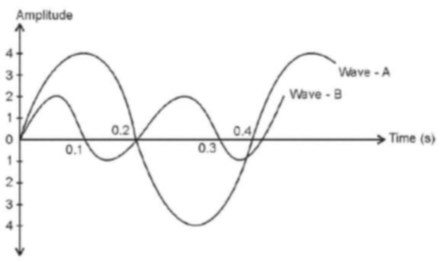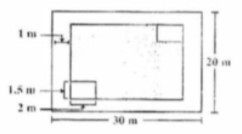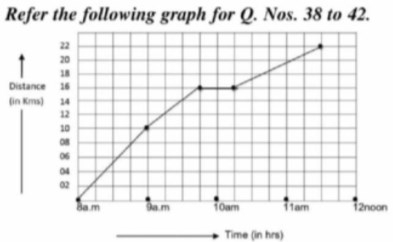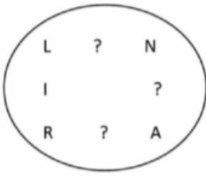
Sainik School Class IX Entrance Examination-2014
Paper-I
Part-A : Mathematics
Directions (Qs. 1 to 20) : Bear 2 marks each.
1. Represent 4/8 and −7/4 on the number line.
2. ![]()
3. The sum of two number is 15 and the sum of their squares is 113. Find the numbers.
4. Multiply : (a + 7) by (a2 + 3a + 5).
5. If ![]() find the value of
find the value of ![]()
6. Factorize: 25a2 – 4b2 + 28bc – 49c2.
7. 
8. Find the square root of 128881 by the division method.
9. Arun bought a pair of Skates at a sale where the discount given was 20%. If the amount he pays is Rs 1600. find the marked price.
10. Find the Compound interest on Rs 12600 for 2 yrs at 10% per annum Compounded annually.
11. Two adjacent angles of a Parallelogram have equal measures. Find the measure of each of the angles of the Parallelogram.
12. An Unbiased Die is thrown. What is the Probability of getting an even number greater than 5?
13. Find the ratio of the circumferences of two concentric circles of radii 2 m and 3 m.
14. The median of the given data is:
133, 73, 89, 108, 94, 140, 94, 85, 100, 120.
(a) 97 (b) 79
(c) 94 (d) None of these
15. Two numbers are in the ratio 5 : 3. If they differ by 18, then the numbers are:
(a) 36 and 54 (b) 36 and 18
(c) 45 and 27 (d) 63 and 45
16. The point (0, 6) lies on:
(a) X-axis (b) Y-axis
(c) Origin (d) None of these
17. The smallest natural number by which 392 must be multiplied so as to get a Perfect Cube is:
(a) 2 (b) 7
(c) 4 (d) 5
18. The diagonals of a rhombus are 64 cm and 48 cm. The height of the rhombus is:
(a) 30.5 cm (b) 36.5 cm
(c) 38.4 cm (d) 58.6 cm
19. In the figure given below, find the value of x.

20. The sum of three consecutive odd numbers is 105. Find the numbers.
Directions (Qs. 21 to 40): Bear 3 marks each.
21. A number consisting of two digits becomes 5/6 of itself, if its digits are interchanged. If the difference of the digits is 1, find the number.
22. ![]()
23. ![]()
24. Find the value of : ![]()
25. If (x + y +z) = 9 and (xy + y z + zx) = 23, then find the value of (x3 + y3 + z3 – 3xyz)/
26. Find the area of a rhombus whose side is 6 cm and whose altitude is 4 cm.
27. ![]()
28. An article was sold at Rs 18000 at a discount of 10%. Find the marked price of the article and the amount of discount allowed.
29. Find k, (3/7)−5 × (7/3)11 = (3/7)8k.
30. Divide: (x3/2 – xy1/2 + x1/2y – y3/2) by (x1/2 – y1/2)
31. There are 100 students in a hostel. Food provision for them is for 20 days. How long will these Provision last, if 25 more students join the group?
32. The area of a trapezium is 384 cm2. If its parallel sides are in the ratio 3:5 and the perpendicular distance between them is 12 cm, find the smaller of parallel sides.
33. If two adjacent angles of a parallelogram are in the ratio 5 : 4, find all the angles of the parallelogram.
34. Find the least number that must be added to 1300 so as to get a Perfect Square.
35. Simplify: (a + b) (c – d) + (a – b) (c + d) + 2(ac + bd).
36. Find the height of a Cylinder whose radius is 7 cm and the total Surface area is 968 cm2.
(Use π = 22/7)
37. Construct a frequency distribution table for the data on weights (in kg) of 20 students of a class using the intervals 30 – 35, 30 – 35 and so on.
40, 38, 33, 48, 60, 53, 31, 46, 34, 36, 49, 41, 55, 49, 65, 42, 44, 47, 38, 39.
38. Rs 1400 is divided among A, B, C so that A receives half as much as B and B receives half as much as C. How much will each of them get?
39. Examine if 117912 is a perfect cube or not. If not, find the smallest positive integer by which it must be multiplied so that the product is a perfect cube.
40. A well with 14 m inside diameter is dug 8 m deep. The Earth taken out of it has been evenly spread all around it to a width of 21 m to form an embankment. Find the height of the embankment.
Directions (Qs. 41 to 50): Bear 10 marks each.
41. Arjun is twice is old as Shriya. Five years ago his age was three times Shriy’s age. Find their present ages.
42. The adjacent figure HOPE is a parallelogram. Find the angles measures x, y and z.

43. A sum of money at compound interest amounts to thrice in 3 years. In how many years will it be 9 times itself at the same rate of interest?
44. (a) Factorise: x2 + 6x – 16.
(b) If a + b = 14 and ab = 20, find the value of a2 + b2
45. A road roller takes 750 complete revolutions to move once over to level a road. Find the area of the road if the diameter of a road roller is 85 cm and length is 1 m.
46. The shape of a garden is rectangular in the middle and semi-circular ends. Total length of the garden including the semi-circular ends is 20 m and its breadth is 7 m. Find the perimeter and area of the garden.
47. The denominator of a rational number is greater than its numerator by 8. If the numerator is increased by 17 and the denominator is decreased by 1, the number obtained is 3/2. Find the rational number.
48. During a Sale, a shop offered a discount of 10% on the marked prices of all the items. What would a customer have to pay for a pair of jeans marked at Rs 1450 and two shirts marked at Rs 850 each?
49. Factorise and then Simplify the expression, 12xy(9x2 – 16y2) ÷ 4xy(3x + 4y).
50. A cow it tied to a pole fixed at one corner of a square field of grass of side 40 m by means of a rope 20 m long. Taking π = 3.14
(i) find the maximum area of the part of the field in which the cow can graze.
(ii) find the area of the remaining part of the field.
(iii) find the length of the rope, if the cow grazes 1256 m2 of the field.
Part-B : Science
Note: Part ‘B’ bearing 75 marks, contains 37 questions, Q. Nos. 1 to 15 carry one mark each, Q. Nos. 16 to 25 carry two marks each Q. Nos. 26 to 35 carry three marks each, Q. Nos. 36 and 37 carry five marks each.
1. Malaria is caused by:
(a) Virus (b) Protozoa
(c) Bacteria (d) Fungi
Answer: (B)
2. The next nearest start to earth other than the Sun is:
(a) Aurora Australis (b) Aurora Barialis
(c) Alpha Centauri (d) Proxima Centauri
Answer: (D)
3. The only non-metal which is liquid in state at room temperature is:
(a) Bromine (b) Boron
(c) Iodine (d) Indium
Answer: (A)
4. A cubical wooden block has the dimension 30 cm × 20 cm × 10 cm, placed on a flat surface. In which of the following cases the pressure applied is maximum?
When it is placed on surface area
(a) 30 cm × 20 cm
(b) 20 cm × 10 cm
(c) 30 cm × 10 cm
(d) None of the above
Answer: (A)
5. What is the time taken by the moon to complete one revolution around the Sun?
(a) 29 days (b) 15 days
(c) 36 days (approx.) (d) 183 days (approx.)
Answer: (A)
6. Which one of the following is not a communicable disease?
(a) Cholera (b) Tuberculosis
(c) Common cold (d) Polio
Answer: (A)
7. Which is correct order to Agricultural practices?
(i) Tilling
(ii) Irrigation
(iii) Sowing
(iv) Adding manure and fertilizer
(v) Harvesting
(a) (i), (iv), (iii), (ii), (v)
(b) (i), (iii), (iv), (ii), (v)
(c) (ii), (i), (iv), (v), (iii)
(d) (i), (ii), (ii), (v), (iv)
Answer: (B)
8. When disease carrying microbe enters our body, the body produces
(a) Antigen (b) Antidote
(c) Antibody (d) Antioxidant
Answer: (C)
9. The gland known as ‘Master gland’ in our body is:
(a) Sweat gland (b) Pituitary gland
(c) Salivary gland (d) Sebaceous gland
Answer: (B)
10. If a ray of light incident on a plane mirror along the normal then the measure of the angle of incidence (in degree)
(a) 90
(b) 45
(c) 0
(d) Depends on which direction the ray is reflected
Answer: (C)
11. The instrument used to detect the charge in a body is
(a) Electrometer (b) Electroscope
(c) Voltmeter (d) Barometer
Answer: (B)
12. For a male child the pair of chromosomes should be
(a) XX (b) XY
(c) YX (d) YY
Answer: (B)
13. The waves produces by earthquake on the surface of earth is known as
(a) Seismic wave (b) Shock wave
(c) Mechanical wave (d) Matter wave
Answer: (A)
14. The axis of the Earth inclined to its orbital plane at an angle of
(a) 23.5 degree (b) 53.6 degree
(c) 66.5 degree (d) 90 degree
Answer: (C)
15. If you stand between two parallel mirrors the number of image/images that you observe is/are
(a) One (b) Two
(c) Eight (d) Infinite
Answer: (D)
16. Write two suitable examples where friction is increased for our benefit.
17. When a copper vessel is exposed to moist air for long it acquires a dull green coating. Why?
18. Why fossil fuels are exhaustible natural resources?
19. What are Endemic and Endangered Species? Give one example of each?
20. A force of 60 N is applied towards east direction.
What is the magnitude and direction of the force so that:
(a) The net force is zero
(b) The net force is 110 N towards East?
21. What are chromosomes? What are their function?
22. What is Global warming? Why it is a major concern for us?
23. Why are the oily food stuffs such as chips and kurkures are kept in sealed packet and flushed with nitrogen?
24. Why ornaments are generally made with Gold and Silver?
25. Paper b itself catches fire easily whereas a piece of paper wrapped around an aluminum pipe does not-Give reason.
26. What is Acid rain? What are its consequences?
27. 
(a) Which sound wave is of more pitch?
(b) Which one is more loud sound?
28. How do amoeba reproduce? Explain in brief with suitable diagram.
29. Write has differences between a plant cell and animal cell.
30. Current is passed through Copper sulphate (blue colour) solution kept in a beaker by two copper rods connected with a battery.
(a) What changes do you notice in the solution and why?
(b) On which electrode a brown deposition is seen?
(c) Mark the two electrodes as anode and cathode.
31. What are Geostationary Satellites? What are their uses?
32. As a member of your society what would you do to reduce air pollution?
33. What are Hormones? Why adrenalin is known as Stress hormone? From where Insulin and Thyroxin hormones are produced?
34. Why lightning occurs between two clouds?
35. How do we hear any sound?
36. Two beakers marked ‘A’ and ‘B’ contains aqueous solution of copper sulphate (CuSO4) and Ferrous sulphate (FeSO4) respectively. An Iron rod is placed in beaker A and a copper rod in beaker B. What changes do you observe after some time in the two beakers?
37. If there is any change explain it with proper chemical equation.
(a) Draw a diagram of human eye and label
(i) Retina (iv) Cilliary muscles
(ii) Optic nerve (v) Eye lens
(iii) Cornea (vi) Iris
(b) How our eye adjusts automatically with the varying intensity of light?
Paper-II
Part-A : English Language
1. Read the following passage and answer the questions that follow. (3 × 5 = 15)
Rain in countryside attracts the lovers of nature. It is pleasant and helpful. But rain in city creates a different kind of sight. For some people the heavy downpour may have a Chilling effect, but it has its charm with the roar of thunder and the flash of lightening. On a rainy day the lanes and the streets look like rivulets, and the entire city becomes magically converted into Venice. The street wears a deserted look. Occasionally a man tries to plod his way. His clothes are tucked up and he holds the umbrella in one hand and his bag in the other. A sudden gush of wind tilts his umbrella and he gets drenched. If a vehicle passes speedily by splashing muddy water on him, he looks a pitiable creature. Sometimes the streets become water-logged and traffic comes to a halt.
The men who dwell in comfortable house sit in their cosy rooms and look out of the window to catch a glimpse of some unusual sight. The howl of the wind and the patters of the rain constitute a symphony for them and some of them fell a poetic fervor in their hearts. The poor persons however, suffer a lot. Leaky roofs, rain-soaked floors and chocked up-drains fill them with despair. The street hawkers cannot carry on their trade. The busy house-wife wears a worry face as her oven does not burn.
Many people come out of their houses and wait for the town buses because they have the urgency of going to their work As the town buses do not come in time they feel irritated. Sometimes they are disappointed. Boys and girls do not go to school because of rain Life is painful when it rains in torrents.
When the rain stops, the sight becomes more interesting. Small children come out to the flooded streets and float paper boats. They like to splash water. Buses and cars begin moving on the streets. Life seems to begin normal activity as if a patient recovers from illness.
(a) How ‘Rain is pleasant and helpful’?
(b) How does rain bring happiness to rich while misery to poor section of the society?
(c) How does rain affect the daily life of the people?
(d) How does the life normalize after the rain subsides?
(e) Pick out the words from the given passage which mean
(i) Wet (para 1)
(ii) Live (paral 2)
(iii) Comfortable (para 2)
2. Write a paragraph in about 100 words on any one of the given topics. (10)
(a) Plan a picnic for your class.
or
(b) Harmful effects of junk fast food.
3. Your are Himanshu, a resident of Benaras Chowk, Ambikapur. Write a letter to the Chairman Municipality expressing your deep concern over the poor condition of roads and the inconvenience faced by the people of our locality.
(Maximum 150 words) (15)
4. Fill in the blanks with appropriate prepositions or adverbs given in the brackets. (2 × 5 = 10)
(a) My mother ran ………(up/out of/into) milk yesterday and I went to buy some.
(b) Could you turn ………….. (out/off/up) the music while I am talking?
(c) Geetanjali’s car broke ………..(up/off/down) on her way to office.
(d) Fazia’s boss called ……. (down/out/off) the
meeting till tomorrow.
(e) That problem is actually quite simple to figure ………. (up/out/down).
5. Complete these sentence by choosing the correct phrases from the brackets.
[poke his nose into, white collar, once in a blue moon, got the green signal, apple of their eyes] (2 × 5 = 10)
(a) Swati’s parents stopped at nothing for her wedding; clearly she is the …………. .
(b) Nishant ……… for his radical project.
(c) Why does he always have to ……… other people’s affairs?
(d) Though my gardener is uneducated and poor, he is saving to send his son to a good school since he wants the boy to get a ………… job.
(e) After joining the coaching classes I …….. get chance to play cricket with my friends.
6. Following sentences are INCORRECT. Find out the error and rewrite the following sentences correctly. (2 × 5 = 10)
(a) Money begets money, Don’t they?
(b) He, I and you were asked to write the details.
(c) They had no manner.
(d) No other boy of the class is more taller than Ram.
(e) No sooner had he reached the station when the train left.
7. Write one word for the following group of words. (1 × 5 = 5)
(a) One who eats human flesh?
(b) A person’s first speech.
(c) One who draws maps and charts.
(d) A group of angry people.
(e) One who dies for country?
8. Frame a meaningful sentence by using each word. (2 × 5 = 10)
(a) Accede, Exceed
(b) Morning, Mourning
(c) Hoist, Host
(d) Temper, Tamper
(e) Differ, Defer
9. Change the following DIRECT sentences into INDIRECT. (1 × 5 = 5)
(a) The student said to his teacher, “Do you teach my brother”?
(b) The cricketers said, “Hurrah! The ICC T20 World Cup is ours”.
(c) The father said to his son. “Don’t walk to fast else you may fall”.
(d) The clerk said to the officer, “Why do you not accept a bribe?”
(e) He said, “Let us to out for a picnic in this lovely weather.”
10. Look at the picture critically, think of a suitable theme and write a story. (in approx. 100 words) (10)

Part-B : Social Studies
1. State True/False. (1 × 15 = 15)
(a) The Battle of Seringapatam was fought between East India Company and Tipu Sultan in 1799.
(b) Captain Alexander Read introduced the Ryotwari system in India.
(c) Kunwar Singh was a leader of the rebel sepoys in Lucknow at the time of the Revolt of 1857.
(d) Dargah means the tomb of a Sufi Saint.
(e) The last Viceroy of British India was Lord Canning.
(f) Emigrants are people who arrive in a country.
(g) Information Technology Industry is known as Sunrise Industry.
(h) Cotton is also known as the ‘Golden Fibre’.
(i) Viticulture means cultivation of grapes.
(j) Kalpakkam nuclear power station is in Karnataka.
(k) Resources that are found everywhere like the air we breathes, are called localized resources.
(l) Sardar Vallabhbhai Patel was the first Deputy Prime Minister of India.
(m) Bhopal Gas Tragedy took place on 02 December, 1986
(n) There are 233 elected members in the Rajya Sabha.
(o) Right to Life is a Fundamental Right Under Article 21 of the Indian Constitution.
2. Fill in the blanks. (1 × 15 = 15)
(a) In 1875, the Arya Samaj was founded by ………… in Bombay.
(b) C. V. Raman was given the Nobel Prize for his work in Physics in ……. .
(c) ……… was the British Military Officer at the time of Jallianwala Bagh Massacre.
(d) Silicon used in the computer industry is obtained from ………. .
(e) ……… is the largest producer of bauxite in the world.
(f) Petroleum and its derivatives are called …….. as they are very valuable.
(g) Silicon Valley is located in ……… .
(h) The Supreme Court of India was established in the year …………. .
(i) In India, Lok Sabha is presided over by the ………. .
(j) The ………. of India is the Supreme Law- making institution.
(k) New Delhi was constructed as a 10-square-mile city on ………….. Hill.
(l) Mala Irular is a tribal group of people who belong to the state of ……… .
(m) Gol Gumbaz, the largest dome in India is located in the state of ……….. .
(n) India’s first satellite ‘Arya-bhatta’ was launched in ………… .
(o) ‘Long Walk to Freedom’ is a book written by ………. .
3. Expand the abbreviations. (1 × 10 = 10)
(a) PIL
(b) EVM
(c) ASEAN
(d) DRDO
(e) FDI
(f) GSI
(g) NHRC
(h) IRBM
(i) ILO
(j) TELCO
4. Match the following columns. (1 × 10 = 10)
(a) Battle of Plassey (i) 1856
(b) Battle of Buxar (ii) 1757
(c) Annexation of Awadh (iii) 1764
(d) Annexation of Sindh (iv) 1849
(e) Annexation of Punjab (v) 1843
(f) Bhangi (vi) Gujarat
(g) Pabhi (vii) Andhra Pradesh
(h) Sikkaliar (viii) Tamil Nadu
(i) Manash National Park (ix) New Delhi
(j) Supreme Court of India (x) Assam
5. Write short notes on any five of the following topics (limit 50 words) (5 × 5 = 25)
(a) Indian women of Olympic Games.
(b) Key features of Indian Constitution.
(c) Right to Education.
(d) The “Blue Rebellion”.
(e) The Battle of Plassey.
(f) Fossil Fuel.
(g) Conservation of Water Resources.
(h) Renewable sources of Energy.











 using law of exponents and powers.
using law of exponents and powers.







 then find the value of x.
then find the value of x.















 is equal to:
is equal to:









 is equal to:
is equal to:

















